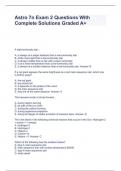A high luminosity star Study guides, Class notes & Summaries
Looking for the best study guides, study notes and summaries about A high luminosity star? On this page you'll find 56 study documents about A high luminosity star.
Page 4 out of 56 results
Sort by
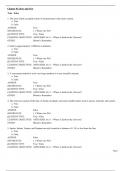
-
Test Bank for Foundations of Astronomy, 14th Edition by Michael A. Seeds
- Exam (elaborations) • 447 pages • 2023
-
- $29.49
- + learn more
Test Bank for Foundations of Astronomy, 14e 14th Edition by Michael A. Seeds, Dana Backman. Full Chapters test bank included Part 1: Exploring the Sky Chapter 1: Here and Now 1-1 Where Are We? 1-2 When Is Now? 1-3 Why Study Astronomy? Chapter 2: A User's Guide to the Sky 2-1 Stars and Constellations 2-2 The Sky and Celestial Motions 2-3 Sun and Planets 2-4 Astronomical Influences on Earth's Climate Chapter 3: Moon Phases and Eclipses 3-1 The Changeable Moon 3-2 Lunar Eclipses...

-
ASTR 1010 / Astronomy 1010 Final HW Complete Questions & Answers.
- Exam (elaborations) • 12 pages • 2023
-
- $10.59
- + learn more
Astronomy 1010 Final HW One of the most important earlier steps in understanding stars was to group them into classes called spectral types that could offer clues as to why they are different from one another. Shown here are spectra of some main-sequence stars. Before stars were very well understood, they were classified into an order that was based on the relative strength of hydrogen absorption lines, marked by arrows the image shown. Look at the spectra for stars of different spectral ...

-
Space Exploration|Complete Questions with A+ Graded Answers
- Exam (elaborations) • 8 pages • 2024
-
Available in package deal
-
- $9.59
- + learn more
Space Exploration|Complete Questions with A+ Graded Answers main sequence a diagonal area on an H-R diagram that includes more than 90 percent of all stars white dwarf A small, hot, dim star that is the leftover center of an old star Luminosity the true brightness of an object light year the distance light travels in one year blueshifted the doppler shift toward shorter wavelengths of light from an approaching object Redshifted stars moving away from Earth Ne...
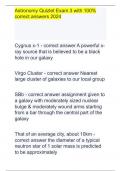
-
Astronomy Quizlet Exam 3 with 100% correct answers 2024.
- Exam (elaborations) • 34 pages • 2024
-
- $7.99
- + learn more
Cygnus x-1 - correct answer A powerful x-ray source that is believed to be a black hole in our galaxy Virgo Cluster - correct answer Nearest large cluster of galaxies to our local group SBb - correct answer assignment given to a galaxy with moderately sized nuclear bulge & moderately wound arms starting from a bar through the central part of the galaxy That of an average city, about 10km - correct answer the diameter of a typical neutron star of 1 solar mass is predicted to be approxima...
Astro 7n Exam 2 Questions With Complete Solutions Graded A+
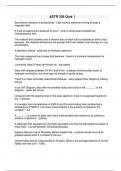
-
ASTR 205 Quiz 1
- Exam (elaborations) • 2 pages • 2023
-
Available in package deal
-
- $10.00
- + learn more
Synchrotron radiation is produced by - high-velocity electrons moving through a magnetic field A Type la supernova is believed to occur - when a white dwarf exceeds the Chandrasekhar limit The material that accretes onto a neutron star or black hole is expected to emit x-rays because - the material will become hot enough that it will radiate most strongly at x-ray wavelengths. A planetary nebula - produces an emission spectrum. The main sequence has a lower limit because - there is a...
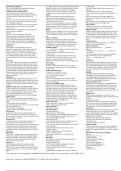
-
astr 115 final exam study guide | Detailed and Complete Solutions
- Exam (elaborations) • 2 pages • 2023
-
- $7.99
- + learn more
Hydrostatic Equilibrium The current distinguishing criterion between dwarf planets and small Solar System bodies Evolution of stars of different mass -Star formation produces a wide variety of stars -Only a few high-mass stars (O, B Type) are produced -The lowest mass stars (eg.M type) are the most common. -If a "star" forms with a mass less than about 1/10 the mass of the Sun, it will not have enough pressure in its core to ignite nuclear fusion. •The lower limit to the mass of a...

-
Astro 7N Final Exam Questions (ANSWERED)
- Exam (elaborations) • 4 pages • 2024
-
Available in package deal
-
- $10.49
- + learn more
A high-luminosity star - Correct Answer emits more light than a low-luminosity star If a red giant appears the same brightness as a red main sequence star, which one is farther away - Correct Answer the red giant the heaviest nuclei of all are formed - Correct Answer during a supernova explosion fill in the blank in the following chemical reaction that occurs in the sun - Correct Answer hydrogen-2 + proton = helium-3 + energy which of the following has the smallest radius - Corre...

-
ASTR 1010 Final Vanderbilt; 100% VERIFIED (GRADED A+)
- Exam (elaborations) • 6 pages • 2023
- Available in package deal
-
- $7.99
- + learn more
dark energy + evidence correct answers a mysterious repulsive force that appears to be causing the expansion of the universe to accelerate Type Ia supernovae as standard candles; Hbl law says they should be moving faster there; inverse square law for light dictates that dimmer = farther; calculated dstncs to things are even farther than their redshift predicts; they are being pushed away dark matter + evidence correct answers matter (gravity, attractive force) that does not give off electr...
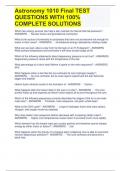
-
Astronomy 1010 Final TEST QUESTIONS WITH 100% COMPLETE SOLUTIONS
- Exam (elaborations) • 6 pages • 2023
-
- $12.99
- + learn more
Astronomy 1010 Final TEST QUESTIONS WITH 100% COMPLETE SOLUTIONS Which two energy sources can help a star maintain its internal thermal pressure? - ANSWERS Nuclear fusion and gravitational contraction What is the source of luminosity for protostars that have not yet become hot enough for fusion in their cores? - ANSWERS Gravitational energy released by infalling matter What can we learn about a star from its life track on an H-R diagram? - ANSWERS What surface temperature...

Did you know that on average a seller on Stuvia earns $82 per month selling study resources? Hmm, hint, hint. Discover all about earning on Stuvia

